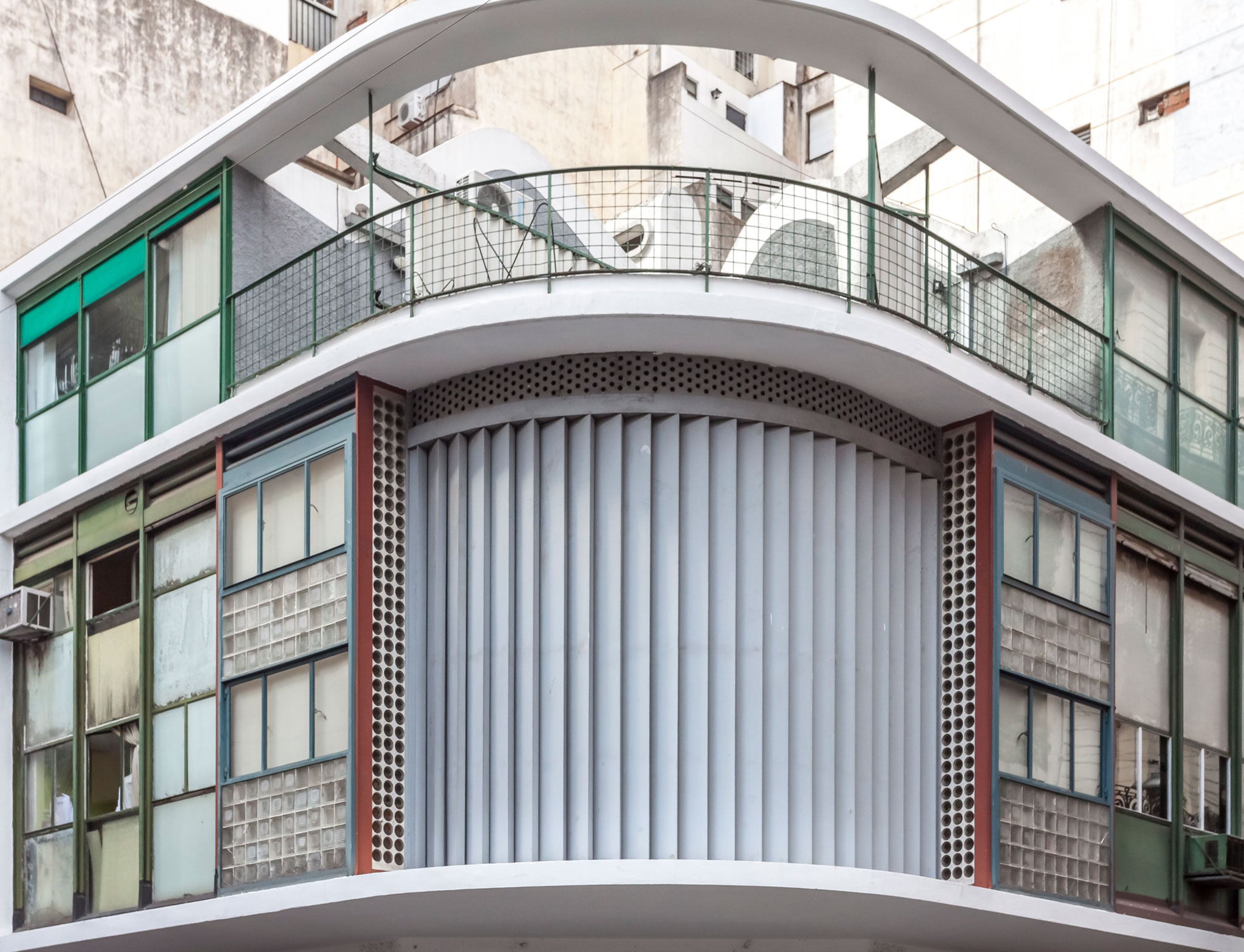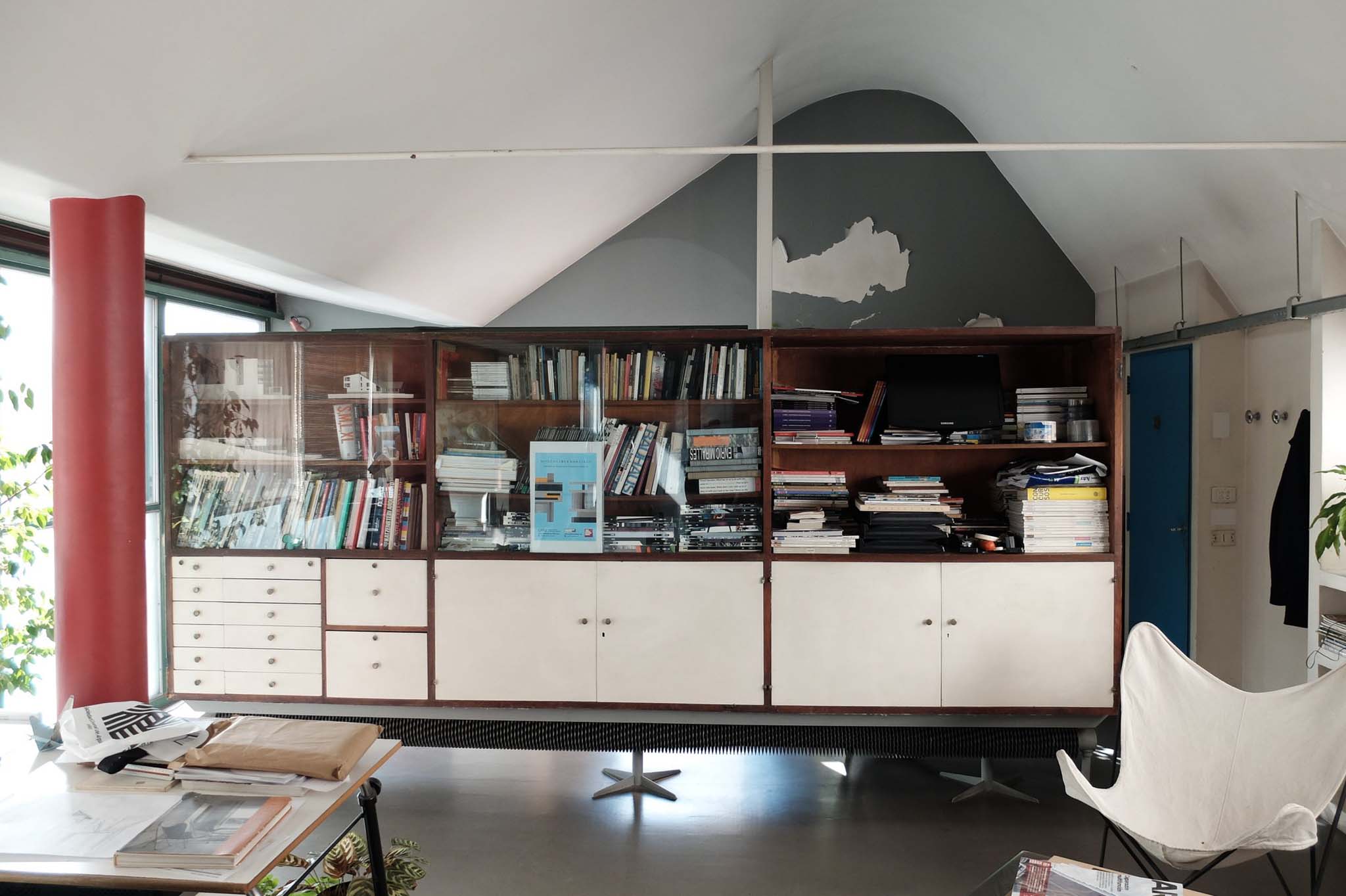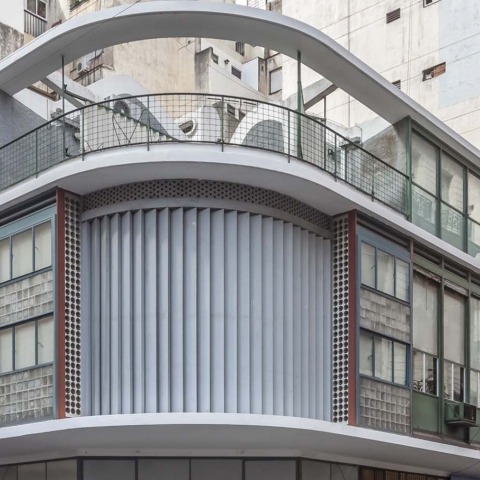In 1938, the architect Antonio Bonet Castellana arrived in exile in Argentina, almost directly from Le Corbusier's studio in Paris. Shortly after, he joined the architects Jorge Ferrari Hardoy and Juan Kurchan, two other architects who were disciples of Le Corbusier, to form a modern architecture group that would serve as a delegation for CIAM and CIRPAC in Argentina, consequently creating what will be known as the Austral Group, whose original claim was to mobilize public opinion to open new alternative paths for architecture.
In addition to these three founding architects, the Austral Group was made up of ten other architects, including Abel López Chas and Ricardo Vera Barros, who partnered with Antonio Bonet Castellana to shortly after design the building of ateliers for artists that is located on the corner between Paraguay and Suipacha streets, on a plot owned by the Vera Barros family that was previously occupied by a 19th-century building and which is located in a commercial area in the center of the Argentine city of Buenos Aires.
The Paraguay y Suipacha building is made up of four commercial premises located on the ground floor and seven studios or ateliers for artists distributed on the two upper floors. Until then, the typology of ateliers for artists did not exist as an alternative in the city of Buenos Aires and, although managing to adapt the project to the grid and subdivision laws of the area was a challenge for Antonio Bonet Castellana, this new typology was also a great opportunity that allowed him great artistic freedom when experimenting and generating new forms that accompanied him in his later career.
In addition to these three founding architects, the Austral Group was made up of ten other architects, including Abel López Chas and Ricardo Vera Barros, who partnered with Antonio Bonet Castellana to shortly after design the building of ateliers for artists that is located on the corner between Paraguay and Suipacha streets, on a plot owned by the Vera Barros family that was previously occupied by a 19th-century building and which is located in a commercial area in the center of the Argentine city of Buenos Aires.
The Paraguay y Suipacha building is made up of four commercial premises located on the ground floor and seven studios or ateliers for artists distributed on the two upper floors. Until then, the typology of ateliers for artists did not exist as an alternative in the city of Buenos Aires and, although managing to adapt the project to the grid and subdivision laws of the area was a challenge for Antonio Bonet Castellana, this new typology was also a great opportunity that allowed him great artistic freedom when experimenting and generating new forms that accompanied him in his later career.

Paraguay-Suipacha Ateliers by Antonio Bonet Castellana. Photograph by Federico Kulekdjian
This plastic freedom is already observed in the composition of the façade, which is clearly divided into three layers that are separated and organized through the white concrete structure and that vary in height depending on the interior rooms of the building. On the ground floor the undulating shop windows of the commercial premises are located, and they combine metallic elements and curved glass that contrast with the rigor of the upper floors, organized based on a precise geometric pattern where up to three different types are combined. of glasses that allow the user to regulate these different degrees of transparency and opacity from the inside.
Another key aspect in this facade composition arises from Antonio Bonet Castellana's desire to renounce the rigid angled chamfer so typical in all corner constructions, and for this, he chose to solve that corner employing a curve on the two upper floors. This curvature is resolved in two different ways in each of these floors, while in the first one an enclosure is proposed formed by a succession of rotating metal slats that are regulated by the user depending on the climate, the upper floor is released generating a vacuum able to accommodate the garden terrace.
Now moving on to the interior distribution of the building, access to it is located on Paraguay Street, since Suipacha Street was wider and therefore more traveled and there was more length of the facade facing towards it, it was decided to locate the four premises commercials with views towards it. This access leads to stairs that lead to the first floor, where there are five of the seven studios or ateliers for artists. These studios have a double-height that is achieved through an upper floor lowered by a tensioner which is accessed by small independent spiral staircases in each studio.
This plastic freedom is already observed in the composition of the façade, which is clearly divided into three layers that are separated and organized through the white concrete structure and that vary in height depending on the interior rooms of the building. On the ground floor the undulating shop windows of the commercial premises are located, and they combine metallic elements and curved glass that contrast with the rigor of the upper floors, organized based on a precise geometric pattern where up to three different types are combined. of glasses that allow the user to regulate these different degrees of transparency and opacity from the inside.
Another key aspect in this facade composition arises from Antonio Bonet Castellana's desire to renounce the rigid angled chamfer so typical in all corner constructions, and for this, he chose to solve that corner employing a curve on the two upper floors. This curvature is resolved in two different ways in each of these floors, while in the first one an enclosure is proposed formed by a succession of rotating metal slats that are regulated by the user depending on the climate, the upper floor is released generating a vacuum able to accommodate the garden terrace.
Now moving on to the interior distribution of the building, access to it is located on Paraguay Street, since Suipacha Street was wider and therefore more traveled and there was more length of the facade facing towards it, it was decided to locate the four premises commercials with views towards it. This access leads to stairs that lead to the first floor, where there are five of the seven studios or ateliers for artists. These studios have a double-height that is achieved through an upper floor lowered by a tensioner which is accessed by small independent spiral staircases in each studio.

Paraguay-Suipacha Ateliers by Antonio Bonet Castellana. Photograph by Federico Kulekdjian
Going up the same nucleus of stairs from the entrance to the building, you reach the upper floor, where the other two studios for the remaining artists are located, which are crowned through sinuous concrete Catalan vaults that at that time were the first built in Argentina. One of these two studios on the upper floor was occupied by Antonio Bonet Castellana himself until 1941, and precisely to equip those ateliers for artists, together with Jorge Ferrari Hardoy and Juan Kurchan, he conceived the BKF armchair, a symbol of modern furniture.
But that upper floor was not only occupied by the studios but, as previously mentioned, a large space in the corner was freed up to house some garden-terraces linked to these workshops. In addition to being a relaxation space for artists, this terrace serves as a viewpoint of the busy urban intersection between Paraguay and Suipacha streets. The terrace is covered with a thick plaster that contrasts with the rest of the materials of the facades of the lower floors that face these streets and is crowned by a curved cornice that is supported by some particular pillars that emerge from the exterior pavement.
The Paraguay y Suipacha building faces the city of Buenos Aires and its problems from a particular interpretation of modern architecture closely linked to the context of the Argentine capital and does so by introducing new factors never seen before and bringing together three such scales in the project. disparate such as urbanism, architecture, and design, thus achieving a relationship with the city and transforming it without renouncing the status of the building as an artistic object.
For all this, on August 8, 2002, the Paraguay and Suipacha building was classified as having a structural protection level in the Buenos Aires Urban Planning Code by the Buenos Aires Legislature and on April 9, 2008, it was declared an element of National Architectural Historical Interest. by the Congress of the Nation.
BIBLIOGRAPHY.-
Going up the same nucleus of stairs from the entrance to the building, you reach the upper floor, where the other two studios for the remaining artists are located, which are crowned through sinuous concrete Catalan vaults that at that time were the first built in Argentina. One of these two studios on the upper floor was occupied by Antonio Bonet Castellana himself until 1941, and precisely to equip those ateliers for artists, together with Jorge Ferrari Hardoy and Juan Kurchan, he conceived the BKF armchair, a symbol of modern furniture.
But that upper floor was not only occupied by the studios but, as previously mentioned, a large space in the corner was freed up to house some garden-terraces linked to these workshops. In addition to being a relaxation space for artists, this terrace serves as a viewpoint of the busy urban intersection between Paraguay and Suipacha streets. The terrace is covered with a thick plaster that contrasts with the rest of the materials of the facades of the lower floors that face these streets and is crowned by a curved cornice that is supported by some particular pillars that emerge from the exterior pavement.
The Paraguay y Suipacha building faces the city of Buenos Aires and its problems from a particular interpretation of modern architecture closely linked to the context of the Argentine capital and does so by introducing new factors never seen before and bringing together three such scales in the project. disparate such as urbanism, architecture, and design, thus achieving a relationship with the city and transforming it without renouncing the status of the building as an artistic object.
For all this, on August 8, 2002, the Paraguay and Suipacha building was classified as having a structural protection level in the Buenos Aires Urban Planning Code by the Buenos Aires Legislature and on April 9, 2008, it was declared an element of National Architectural Historical Interest. by the Congress of the Nation.
BIBLIOGRAPHY.-
- Liernur, Jorge Francisco / Pschepiurca, Pablo. (2012). "La red austral. Obras y proyectos de Le Corbusier y sus discípulos en la Argentina (1924-1965)". Buenos Aires: Universidad Nacional de Quilmes. Chapter VII.
- Hernández Soriano, Ricardo. (2016). "Ciudad, arquitectura y patrimonio. Antonio Bonet y el Grupo Austral, el valor de un manifiesto". Madrid: Universidad Complutense de Madrid, pp. 289-296.
- Bonet Castellana, Antonio. (1995). "La experiencia del exilio: un encuentro en Santiago, 1975". Madrid: COAM. Revista Arquitectura. Issue 303, pp. 22-34.
- Bonet Castellana, Antonio. (1987). "Antonio Bonet". Barcelona: COAC. Quaderns d’arquitectura i urbanisme. Issue 174, pp. 52-75.
- Hernández Soriano, Ricardo. (2016). "Ciudad, arquitectura y patrimonio. Antonio Bonet y el Grupo Austral, el valor de un manifiesto". Madrid: Universidad Complutense de Madrid, pp. 289-296.
- Bonet Castellana, Antonio. (1995). "La experiencia del exilio: un encuentro en Santiago, 1975". Madrid: COAM. Revista Arquitectura. Issue 303, pp. 22-34.
- Bonet Castellana, Antonio. (1987). "Antonio Bonet". Barcelona: COAC. Quaderns d’arquitectura i urbanisme. Issue 174, pp. 52-75.































































